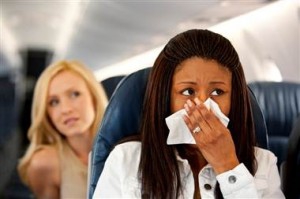If orange juice and multivitamins are your go-to staples for staying healthy while traveling, you may want to rethink your defense strategy.
Research shows that disease-causing bacteria can linger on airplane surfaces for up to a week, according to the American Society of Microbiology in Boston.
The study tested if two types of bacteria that can lead to scary health problems – E. coli and Methicillin-resistant Staphylococcus aureus (MRSA) – could survive in various places on a place like window shades, leather seats and plastic tray tables. Researchers exposed the pathogens to airplane-like conditions and found that MRSA survived a whole seven days on the seat-back pocket, and E. coli lasted four days on the armrest.
But, even though porous materials like the seat-back pocket harbor germs for longer, you’re more likely to transmit bacteria to your hands when you come in contact with flatter, less porous surfaces like the plastic tray tables window shades, the study’s author, Kiril Vaglenov, said. The cloth tends to trap bacteria in the small fibers and makes it difficult for the bacteria to transfer to skin.
Another germy place on an airplane is the bathroom, which is typically shared with 50 to 75 people on each flight, said University of Arizona Professor of Microbiology Charles Gerba, Ph.D. The sink and door handle can get pretty gross over the course of a long flight, and a lack of proper cleaning in between flights can contribute to the overall nastiness.
“They turn planes over so fast, and there are no rules or requirements for disinfecting or cleaning airplanes,” Gerba told Women’s Health. “They pick up the litter, but they don’t really disinfect [planes].
Protect yourself on your next flight using Gerba’s tips:
Use Hand Sanitizer
It’s your best line of defense since most germs are picked up through direct contact. Make sure to bring hand sanitizer in your carry on and use it before eating and after using the restroom.
Minimize Contact
One of the most dreaded sounds on a flight is someone in proximity to your seat coughing profusely, but most viruses are transmitted through hand-to-face contact. Avoid touching your eyes, nose and mouth as much as possible, which adults do at an average of 16 times per hour.
Wipe Down Your Tray
“Everyone uses the trays to eat, drink and play cards,” Gerba said. In another study, he found norovirus and flu bacteria on tray tables. Pack disposable disinfectant wipes and wipe down your tray before using it.

 Save up to 60% on Business Class. Call 1-800-435-8776
Save up to 60% on Business Class. Call 1-800-435-8776

Leave A Comment